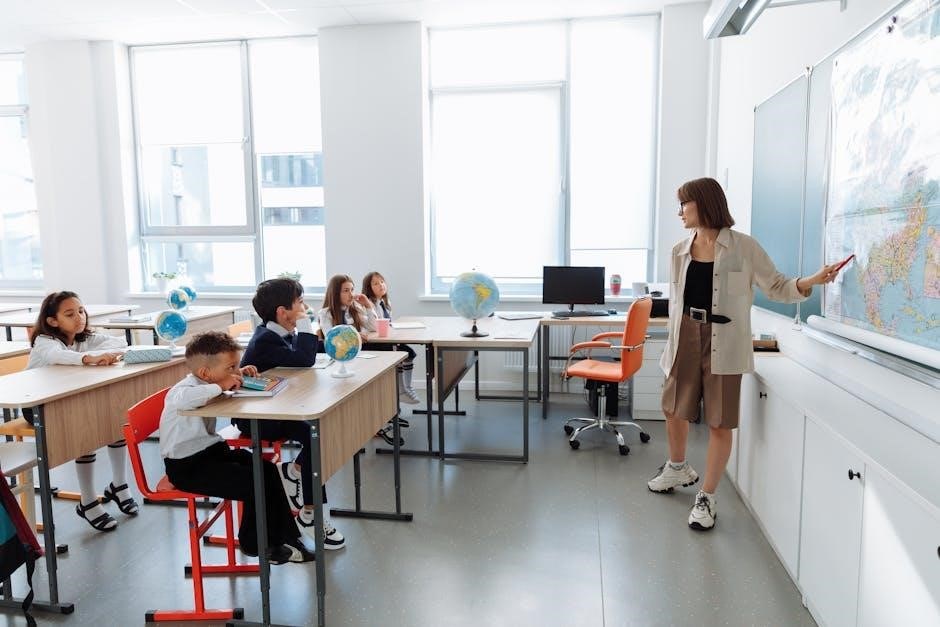The Berg Instructional Center (BIC) is a key educational facility at the College of DuPage, offering diverse academic resources, classrooms, and student services. Located at 425 Fawell Blvd, Glen Ellyn, IL, it provides a comprehensive learning environment with modern classrooms, offices, and common areas. The center is easily navigable using the campus map, ensuring accessible education and support for students and visitors alike.
Overview of the Berg Instructional Center
The Berg Instructional Center (BIC) is a central hub at the College of DuPage, designed to support academic and student success. Located at 425 Fawell Blvd, Glen Ellyn, IL, it houses classrooms, offices, and key facilities for both students and faculty. The center features a well-organized layout, with Level 0 and Level 1 offering distinct spaces tailored for learning and collaboration. Key locations include classrooms, meeting rooms, elevators, stairs, restrooms, and student service areas. The BIC map provides detailed navigation, ensuring easy access to these resources. As part of the College of DuPage, the Berg Instructional Center plays a vital role in fostering education and community engagement, making it a cornerstone of campus life.
Historical Background and Significance
The Berg Instructional Center (BIC) has a rich history as a cornerstone of the College of DuPage, established to meet the growing educational needs of the community. Originally designed to house classrooms and instructional spaces, it has evolved into a hub for academic and student support services. Named in recognition of its significance to the college’s mission, the BIC has played a pivotal role in fostering learning and innovation. Over the years, it has undergone updates to integrate modern technology and adaptive learning environments, ensuring it remains a vital resource for students and faculty. The center’s enduring legacy reflects its commitment to advancing education and community engagement in Glen Ellyn, Illinois.

Location and Directions
The Berg Instructional Center is located at 425 Fawell Blvd, Glen Ellyn, IL 60137. Easily accessible via I-88 and I-355, with ample parking nearby.
Real-Time Directions with Waze
For convenient navigation to the Berg Instructional Center, use the Waze app for real-time directions. Simply enter the address: 425 Fawell Blvd, Glen Ellyn, IL 60137. Waze provides optimal routes based on current traffic conditions, ensuring a smooth journey. Voice-guided navigation helps you stay focused on the road. The app also offers alternative routes if delays occur. Once near the campus, follow signs to the Berg Instructional Center, located near the heart of the College of DuPage. Parking options are available in nearby lots, with clear signage directing you to the building. This feature is ideal for first-time visitors or those unfamiliar with the campus layout.
Using the College of DuPage Campus Map
The College of DuPage Campus Map is an essential tool for navigating the campus and locating the Berg Instructional Center. Available both online and in print, the map provides a detailed layout of all campus buildings, parking lots, and key landmarks. The online version is interactive, allowing users to zoom in and out and search for specific buildings by name. To find the Berg Instructional Center, simply type its name into the search bar, and the map will highlight its location. The map is color-coded to differentiate between various types of buildings and includes labels for each structure. Additionally, it highlights pedestrian pathways, accessible routes, and the locations of parking areas nearest to the Berg Instructional Center. By referring to the campus map, visitors can efficiently locate the Berg Instructional Center and plan their route accordingly, ensuring a hassle-free experience when visiting the College of DuPage.

Building Layout and Key Locations
The Berg Instructional Center features a modern, accessible design with multiple levels, housing classrooms, offices, and common areas. Elevators and clear signage facilitate easy navigation.
Level 0 Layout and Key Locations
Level 0 of the Berg Instructional Center serves as the main entry point, featuring a spacious lobby and welcome center. This level is home to essential facilities, including the Testing Center, academic support services, and administrative offices. Key locations such as the Student Services Area and the main elevator bank are conveniently located near the entrance, ensuring easy access for all visitors. The layout is designed to promote navigation, with clear signage and accessible pathways connecting to classrooms, laboratories, and common areas. Restrooms and drinking fountains are also strategically placed for convenience. This level is a hub for student activity, providing a welcoming and functional environment for learning and collaboration.
Level 1 Layout and Key Locations
Level 1 of the Berg Instructional Center is primarily dedicated to academic spaces, including classrooms, laboratories, and faculty offices. This level is designed to support interactive learning, with state-of-the-art classrooms equipped with advanced technology such as smartboards and flexible seating arrangements. Key locations include the mathematics and science labs, which provide hands-on learning opportunities. Faculty offices are strategically placed near teaching spaces, allowing for easy student access. Additionally, Level 1 features collaborative study areas and a student lounge, fostering a dynamic environment for both learning and relaxation. The layout ensures seamless navigation, with clear pathways connecting all major facilities. Restrooms and vending machines are also conveniently located on this level.

Available Services and Facilities
The Berg Instructional Center provides a variety of academic and student support services, including tutoring, advising, and access to modern classrooms and computer labs.
Testing Center at Berg Instructional Center
The Berg Instructional Center houses a state-of-the-art Testing Center designed to accommodate academic assessments, placement exams, and proctored testing for online courses.
Equipped with modern technology, the center ensures a secure and quiet environment for test-takers. Students can access computers, scanners, and other resources to complete their exams efficiently.
The Testing Center also offers accommodations for students with disabilities, including private testing rooms and assistive technologies, ensuring equal access to academic opportunities.
Students are encouraged to schedule their tests in advance to avoid delays. The center’s staff provides support and guidance to ensure a smooth testing experience.
Whether for placement, certification, or course completion, the Berg Testing Center is a vital resource for academic success at the College of DuPage.
Student Services Area
The Student Services Area at the Berg Instructional Center serves as a central hub for academic and personal support, offering a variety of resources to help students succeed.
Located on Level 1, this area provides easy access to advising, counseling, and registration services, ensuring students can navigate their academic journey seamlessly.
Additionally, the Student Services Area includes resources for financial aid, tutoring, and career services, creating a one-stop destination for student needs.
The convenient location near key facilities like the Testing Center and classrooms makes it a hub for student activity and support.
Students can also find information about campus events, workshops, and community resources, fostering a well-rounded educational experience.
The area is designed to be welcoming and accessible, ensuring all students feel supported in achieving their academic goals.
For further assistance, students can visit the area during operating hours or contact the center directly for personalized support.

Related Centers and Facilities
Nearby facilities include the Culinary & Hospitality Center, Greenhouse, and Homeland Security Education Center, offering diverse resources for specialized learning and community engagement.
Culinary & Hospitality Center (CHC)
The Culinary & Hospitality Center (CHC) is a state-of-the-art facility offering culinary and hospitality education. It features professional kitchens, dining areas, and event spaces for hands-on learning. Students gain practical experience in food preparation, restaurant management, and event planning. The CHC also hosts community events, workshops, and dining experiences, making it a hub for culinary innovation and skill development. Its proximity to the Berg Instructional Center enhances interdisciplinary collaboration and access to resources. This center is a key part of the College of DuPage’s commitment to excellence in specialized education and community engagement.
Greenhouse (GH)
The Greenhouse (GH) at the College of DuPage is a cutting-edge facility dedicated to horticulture, botany, and sustainability education. It provides students with hands-on experience in plant propagation, hydroponics, and environmental science. The GH also serves as a research hub for innovative gardening practices and sustainable agriculture. Community members can participate in workshops and events hosted here. Its proximity to the Berg Instructional Center ensures easy access for students and visitors. The Greenhouse plays a vital role in promoting environmental awareness and fostering a deeper connection with nature through education and community engagement.
Homeland Security Education Center (HEC)
The Homeland Security Education Center (HEC) is a state-of-the-art facility located near the Berg Instructional Center. It serves as a premier training and education hub for homeland security, emergency management, and public safety. The HEC offers specialized programs, simulations, and resources to prepare students and professionals for real-world challenges. Its cutting-edge technology and expert-led training sessions make it a vital resource for those pursuing careers in security and emergency response. The center also collaborates with local, state, and federal agencies to ensure up-to-date training. Its proximity to the Berg Instructional Center allows seamless integration with other academic programs, enhancing the overall educational experience for students.

Technological Features
The Berg Instructional Center is equipped with modern technological features, including interactive classrooms, smartboards, and high-speed Wi-Fi, ensuring an advanced learning environment for students and faculty.
Classrooms and Office Spaces
The Berg Instructional Center features modern classrooms equipped with state-of-the-art technology, including smartboards, projectors, and interactive learning tools. These spaces are designed to promote collaborative learning and flexibility, with modular seating arrangements and access to power outlets. Faculty offices are strategically located near classrooms, fostering easy access for students and staff. Many classrooms also include breakout rooms for smaller group work and presentations. The center emphasizes accessibility, with ADA-compliant classrooms and office spaces. Additionally, faculty offices are equipped with advanced communication tools, ensuring efficient coordination and support for academic activities. The integration of technology and ergonomic design creates an optimal environment for both teaching and learning.
Meeting Rooms and Event Spaces
The Berg Instructional Center offers versatile meeting rooms and event spaces designed to accommodate a variety of activities. These spaces are equipped with advanced audio-visual technology, including high-definition displays, sound systems, and video conferencing capabilities. Meeting rooms feature flexible seating arrangements, ranging from boardroom-style setups to collaborative configurations. Event spaces can host larger gatherings, such as workshops, seminars, and receptions. Many areas are adorned with natural lighting, creating a welcoming atmosphere for both formal and informal events. The center also provides access to catering services and event planning support to ensure seamless execution of functions. These facilities make the Berg Instructional Center a prime location for academic and community events.
Elevators, Stairs, and Restrooms
The Berg Instructional Center is equipped with modern elevators, stairs, and restrooms to ensure easy navigation and accessibility. Elevators are located at both ends of the building, providing convenient access to all levels. Staircases are centrally located and well-lit, offering a quick way to move between floors. Restrooms are available on each level, with clear signage for easy location. Additionally, some restrooms are ADA-compliant, featuring grab bars, lowered sinks, and emergency alarms. The facilities are maintained regularly to ensure cleanliness and functionality. These amenities contribute to a smooth and accessible experience for all students, faculty, and visitors within the Berg Instructional Center.
Student Lounges and Common Areas
The Berg Instructional Center features several student lounges and common areas designed to foster relaxation and collaboration. These spaces are strategically located on each level, offering comfortable seating and a welcoming environment for students to take breaks or study informally. Some lounges are equipped with charging stations for electronic devices, while others provide vending machines for snacks. Large windows in these areas allow natural light, creating a pleasant atmosphere. Group study tables and soft seating areas are also available, making them ideal for collaborative work or casual gatherings. These spaces are popular among students for unwinding between classes or engaging in informal learning sessions, enhancing the overall campus experience.

Directions and Parking Information
The Berg Instructional Center is located at 425 Fawell Blvd, Glen Ellyn, IL 60137. Visitor parking is available in Lot 1, near the main entrance.
Navigation Tips for Easy Access
For seamless navigation to the Berg Instructional Center, use digital tools like the College of DuPage campus map or Waze for real-time directions. Upon arrival, follow signs to the main entrance on Level 1.
Once inside, check the digital directories for classroom or service locations. Elevators and stairwells are centrally located, ensuring easy access between levels.
Plan your route in advance using the online map to avoid delays. For visitors, parking in Lot 1 offers the shortest walk to the building. Accessibility features, including ramps and restrooms, are clearly marked throughout the facility.
Download the College of DuPage app for a interactive map and updates on campus events or construction.

Contact Information and Hours of Operation
The Berg Instructional Center is located at 425 Fawell Blvd, Glen Ellyn, IL 60137. For general inquiries, call (630) 942-3000 or visit the College of DuPage website for specific department contacts.
Hours of operation vary by semester but typically run Monday through Thursday from 7:00 AM to 10:00 PM and Friday from 7:00 AM to 5:00 PM.
Saturday hours are 8:00 AM to 1:00 PM, while Sundays are closed. Check the College of DuPage website for holiday closures or special events. For specific services like the Testing Center, call (630) 942-2626 or visit their webpage for scheduling.
Plan your visit by confirming hours in advance, as they may change during breaks or summer sessions.

Importance of the Map for Students and Visitors
The Berg Instructional Center map is an essential tool for navigating the facility efficiently. It provides clear directions to classrooms, testing centers, and student service areas, ensuring students and visitors can locate their destinations quickly.
Key locations, such as the Testing Center and Student Services Area, are highlighted to simplify the navigation process. Real-time directions and accessibility information are also included, making it easier for everyone to move around the building.
For new students or first-time visitors, the map serves as a guide to explore the facility confidently.
It helps save time and reduces stress, ensuring a smooth experience while utilizing the center’s resources.
Regularly updated, the map reflects any changes in the building layout or services, making it a reliable resource for all users.

Emergency Services and Accessibility
The Berg Instructional Center map is crucial for identifying emergency services and accessibility features. It highlights emergency exits, fire alarms, and evacuation routes, ensuring quick access during emergencies.
Accessible pathways, ramps, and elevators are clearly marked for individuals with mobility challenges.
Restrooms with ADA compliance and tactile signage are also indicated for ease of navigation.
Emergency contact information and the location of first aid kits are included for preparedness.
The map ensures that all users, including those with disabilities, can navigate safely and efficiently.
Regular updates reflect any changes to emergency procedures or accessibility features.
This ensures a secure and inclusive environment for everyone utilizing the facility.
Scheduling and Events
The Berg Instructional Center map aids in room reservations and event planning. Classrooms, meeting rooms, and event spaces are available for booking through the college’s online system.
Event coordination services and room setup options are accessible to ensure seamless scheduling. The map helps users identify available spaces and plan events efficiently.
Room Reservations and Event Planning
The Berg Instructional Center map is a valuable tool for room reservations and event planning. It provides detailed layouts of classrooms, meeting rooms, and event spaces, allowing users to visualize and select appropriate locations.
Interactive features enable users to check real-time availability and reserve spaces through the college’s online system. Event planners can utilize the map to coordinate layouts, seating arrangements, and accessibility routes. Additionally, the map highlights nearby facilities, such as restrooms, elevators, and parking, ensuring seamless event execution. This resource streamlines the planning process, making it easier to host successful events and meetings at the Berg Instructional Center.

















